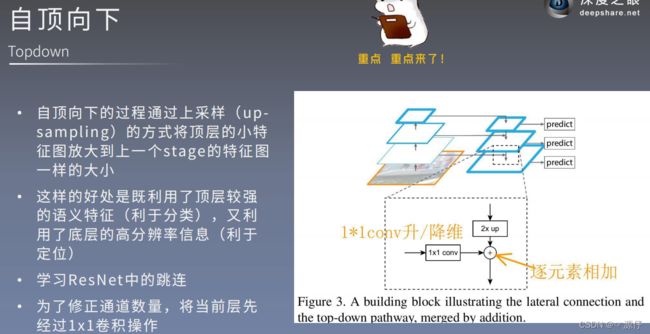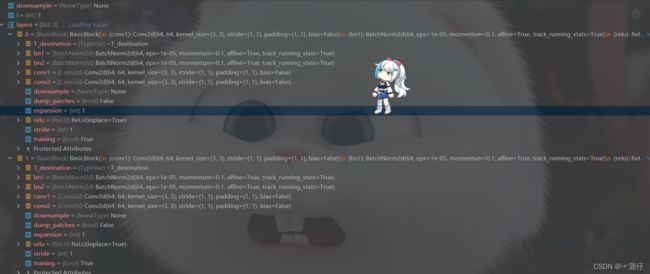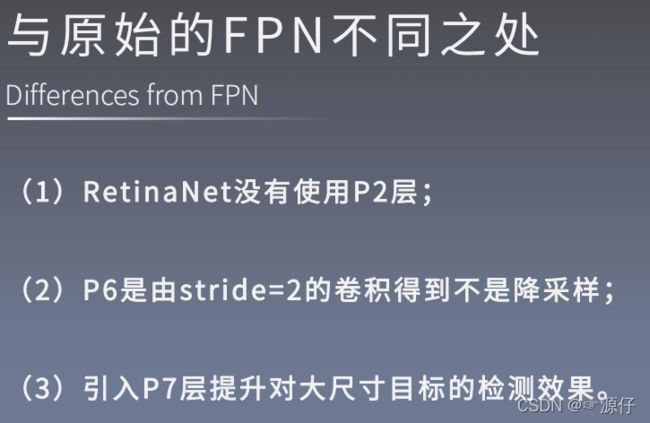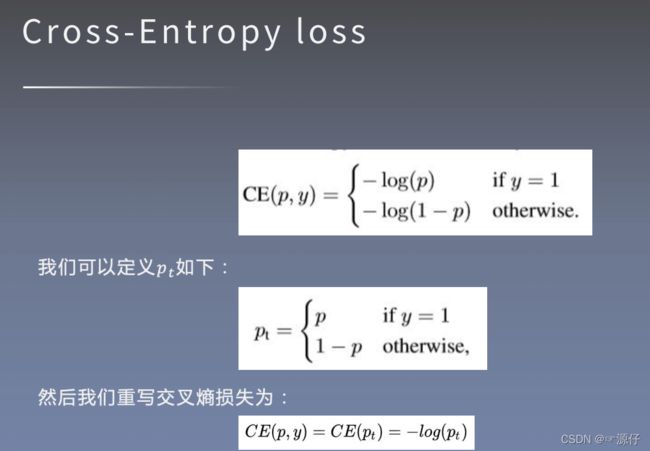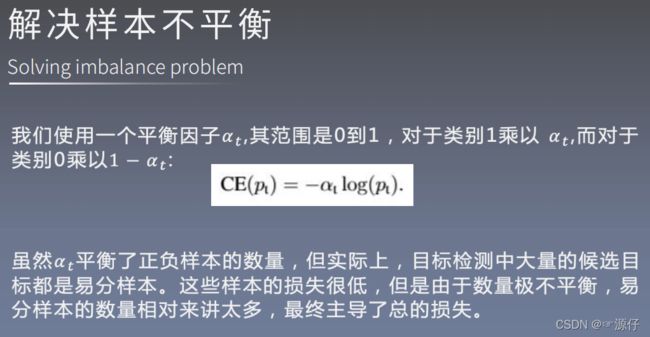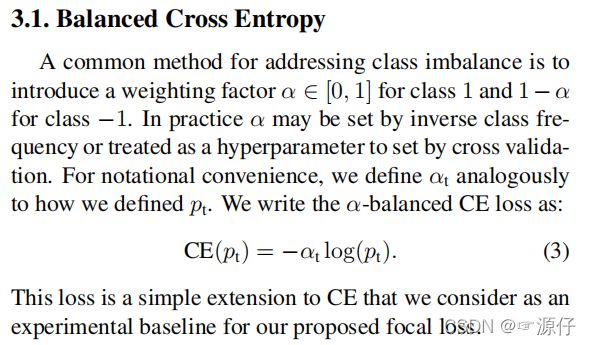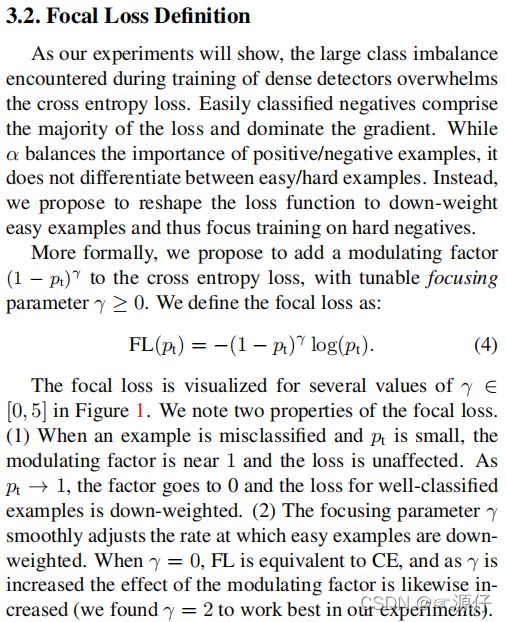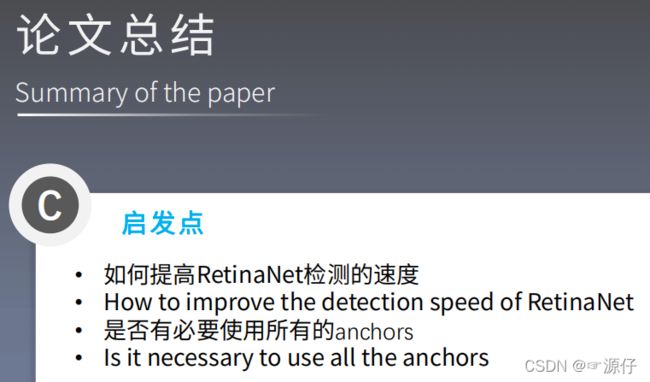RetinaNet详解(附Pytorch代码讲解)
文章目录
- 1、RetianaNet研究背景和意义
-
- 1.1 目标检测发展脉络
- 1.2 、为什么One-stage精度低
-
- 1.2.1 Faster Rcnn如何处理样本均衡问题
- Hard Negitivate Mining
- 2、ResNet18
-
- 2.1、def _make_layer(self, block, planes, blocks, stride=1):详解
-
- 2.1.1 、layers.append()
- 2.2、self.layer2[layers[1] - 1].conv2.out_channels
- 2.3、FPN详解(第3节详细分析)
- 2.4、Anchor.py
- 2. 5、resnet18、34、50、101、152
- 3、传统FocalLoss详解
-
- 3.1、FocalLoss是怎么改进得来的?
-
- 3.1.1 CE交叉熵损失
- 3.1.2、Balanced Cross Entropy
- 3.1.3、Focal Loss Definition
- 3、FPN特征融合
- 4、RetainNet总结
1、RetianaNet研究背景和意义
1.1 目标检测发展脉络
1.2 、为什么One-stage精度低
- 正样本: 与真值对应的目标类别来说该样本为正样本。
- 负样本: 与真值不对应的其他所有目标类别来说该样本为负样本。
- 困难样本: 预测时与真值标签误差较大的样本。
- 简单样本: 预测时与真值标签误差较小的样本。
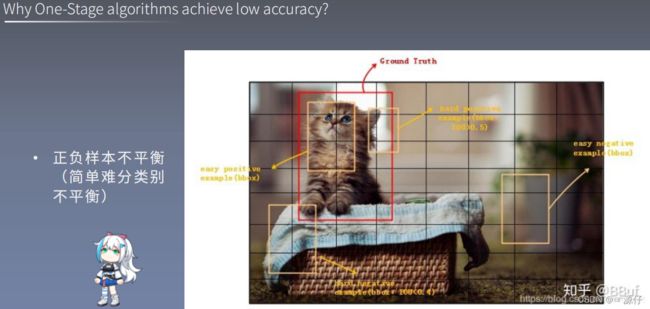
由上图我们可知,目标检测中,我们分为正负样本以及Easy example、Hard example。这样就分成了四种样本:easy Positive example、easy negitivate example、hard Positive example、hard negitivate example。
hard Positive example:boxs、Iou>0.5
hard negitivate example: boxs、Iou<0.4
大概意思就是一个中学生,如果你一直叫他去写小学生的卷子,那么他的成绩不会提升,如果叫他写很难的卷子,这样会很打击他的信心,要有个权衡。
1.2.1 Faster Rcnn如何处理样本均衡问题
Hard Negitivate Mining
RCNN 的 Hard Negative Mining的原理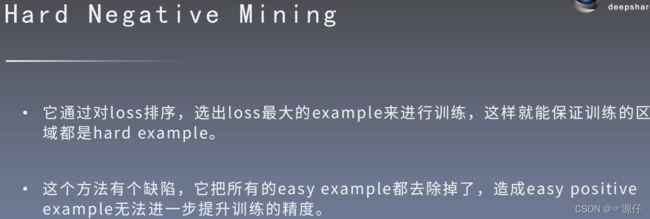
2、ResNet18
class ResNet(nn.Module):
# block: 写在utils.py文件中的类class BasicBlock(nn.Module)、class Bottleneck(nn.Module)
def __init__(self, num_classes, block, layers):
self.inplanes = 64
super(ResNet, self).__init__()
self.conv1 = nn.Conv2d(3, 64, kernel_size=7, stride=2, padding=3, bias=False)
self.bn1 = nn.BatchNorm2d(64)
self.relu = nn.ReLU(inplace=True)
self.maxpool = nn.MaxPool2d(kernel_size=3, stride=2, padding=1)
#resnet18的layers为[2,2,2,2]
self.layer1 = self._make_layer(block, 64, layers[0])
self.layer2 = self._make_layer(block, 128, layers[1], stride=2)
self.layer3 = self._make_layer(block, 256, layers[2], stride=2)
self.layer4 = self._make_layer(block, 512, layers[3], stride=2)
if block == BasicBlock:
fpn_sizes = [self.layer2[layers[1] - 1].conv2.out_channels, self.layer3[layers[2] - 1].conv2.out_channels,
self.layer4[layers[3] - 1].conv2.out_channels]
elif block == Bottleneck:
fpn_sizes = [self.layer2[layers[1] - 1].conv3.out_channels, self.layer3[layers[2] - 1].conv3.out_channels,
self.layer4[layers[3] - 1].conv3.out_channels]
else:
raise ValueError(f"Block type {block} not understood")
self.fpn = PyramidFeatures(fpn_sizes[0], fpn_sizes[1], fpn_sizes[2])
self.regressionModel = RegressionModel(256)
self.classificationModel = ClassificationModel(256, num_classes=num_classes)
self.anchors = Anchors()
self.regressBoxes = BBoxTransform()
self.clipBoxes = ClipBoxes()
self.focalLoss = losses.FocalLoss()
for m in self.modules():
if isinstance(m, nn.Conv2d):
n = m.kernel_size[0] * m.kernel_size[1] * m.out_channels
m.weight.data.normal_(0, math.sqrt(2. / n))
elif isinstance(m, nn.BatchNorm2d):
m.weight.data.fill_(1)
m.bias.data.zero_()
prior = 0.01
self.classificationModel.output.weight.data.fill_(0)
self.classificationModel.output.bias.data.fill_(-math.log((1.0 - prior) / prior))
self.regressionModel.output.weight.data.fill_(0)
self.regressionModel.output.bias.data.fill_(0)
self.freeze_bn()
def _make_layer(self, block, planes, blocks, stride=1):
downsample = None
if stride != 1 or self.inplanes != planes * block.expansion:
downsample = nn.Sequential(
nn.Conv2d(self.inplanes, planes * block.expansion,
kernel_size=1, stride=stride, bias=False),
nn.BatchNorm2d(planes * block.expansion),
)
layers = [block(self.inplanes, planes, stride, downsample)]
self.inplanes = planes * block.expansion
for i in range(1, blocks):
layers.append(block(self.inplanes, planes))
return nn.Sequential(*layers)
def freeze_bn(self):
'''Freeze BatchNorm layers.'''
for layer in self.modules():
if isinstance(layer, nn.BatchNorm2d):
layer.eval()
def forward(self, inputs):
#backbone网络下采样提取不同scale特征,得到C3、C4、C5
if self.training:
img_batch, annotations = inputs
else:
img_batch = inputs
#img_batch [batch,3,H,W]
x = self.conv1(img_batch)
x = self.bn1(x)
x = self.relu(x)
x = self.maxpool(x)
x1 = self.layer1(x) #输出size为:[batch,64,H//4,W//4]
x2 = self.layer2(x1) #输出size为:[batch,128,H//8,W//8]
x3 = self.layer3(x2) #输出size为:[batch,256,H//16,W//16]
x4 = self.layer4(x3) #输出size为:[batch,512,H//32,W//32]
# 特征金字塔,将C3、C4、C5三个scale的feature map进行上采样融合,生成P3到P7共5个scale的feature map
features = self.fpn([x2, x3, x4])
# 循环P3到P7,以此进行回归和分类操作
regression = torch.cat([self.regressionModel(feature) for feature in features], dim=1)
classification = torch.cat([self.classificationModel(feature) for feature in features], dim=1)
#生成anchor
anchors = self.anchors(img_batch)
if self.training:
return self.focalLoss(classification, regression, anchors, annotations) # 有了分类、回归、anchor、target标签,就能计算loss
else:
transformed_anchors = self.regressBoxes(anchors, regression)
transformed_anchors = self.clipBoxes(transformed_anchors, img_batch)
finalResult = [[], [], []]
finalScores = torch.Tensor([])
finalAnchorBoxesIndexes = torch.Tensor([]).long()
finalAnchorBoxesCoordinates = torch.Tensor([])
if torch.cuda.is_available():
finalScores = finalScores.cuda()
finalAnchorBoxesIndexes = finalAnchorBoxesIndexes.cuda()
finalAnchorBoxesCoordinates = finalAnchorBoxesCoordinates.cuda()
for i in range(classification.shape[2]):
scores = torch.squeeze(classification[:, :, i])
scores_over_thresh = (scores > 0.05)
if scores_over_thresh.sum() == 0:
# no boxes to NMS, just continue
continue
scores = scores[scores_over_thresh]
anchorBoxes = torch.squeeze(transformed_anchors)
anchorBoxes = anchorBoxes[scores_over_thresh]
anchors_nms_idx = nms(anchorBoxes, scores, 0.5)
finalResult[0].extend(scores[anchors_nms_idx])
finalResult[1].extend(torch.tensor([i] * anchors_nms_idx.shape[0]))
finalResult[2].extend(anchorBoxes[anchors_nms_idx])
finalScores = torch.cat((finalScores, scores[anchors_nms_idx]))
finalAnchorBoxesIndexesValue = torch.tensor([i] * anchors_nms_idx.shape[0])
if torch.cuda.is_available():
finalAnchorBoxesIndexesValue = finalAnchorBoxesIndexesValue.cuda()
finalAnchorBoxesIndexes = torch.cat((finalAnchorBoxesIndexes, finalAnchorBoxesIndexesValue))
finalAnchorBoxesCoordinates = torch.cat((finalAnchorBoxesCoordinates, anchorBoxes[anchors_nms_idx]))
return [finalScores, finalAnchorBoxesIndexes, finalAnchorBoxesCoordinates]
2.1、def _make_layer(self, block, planes, blocks, stride=1):详解
def _make_layer(self, block, planes, blocks, stride=1):
downsample = None
if stride != 1 or self.inplanes != planes * block.expansion:
downsample = nn.Sequential(
nn.Conv2d(self.inplanes, planes * block.expansion,
kernel_size=1, stride=stride, bias=False),
nn.BatchNorm2d(planes * block.expansion),
)
layers = [block(self.inplanes, planes, stride, downsample)]
self.inplanes = planes * block.expansion
for i in range(1, blocks):
layers.append(block(self.inplanes, planes))
return nn.Sequential(*layers)
其中 self.layer1 = self._make_layer(block, 64, layers[0])中的layers如下图所示:

2.1.1 、layers.append()
**===============================================**
for i in range(1, blocks):
layers.append(block(self.inplanes, planes))
2.2、self.layer2[layers[1] - 1].conv2.out_channels
if block == BasicBlock:
fpn_sizes = [self.layer2[layers[1] - 1].conv2.out_channels, self.layer3[layers[2] - 1].conv2.out_channels,
self.layer4[layers[3] - 1].conv2.out_channels]
elif block == Bottleneck:
fpn_sizes = [self.layer2[layers[1] - 1].conv3.out_channels, self.layer3[layers[2] - 1].conv3.out_channels,
self.layer4[layers[3] - 1].conv3.out_channels]
else:
raise ValueError(f"Block type {block} not understood")
以**resnet18**为例,这里对上面程序做单独的解析输出:
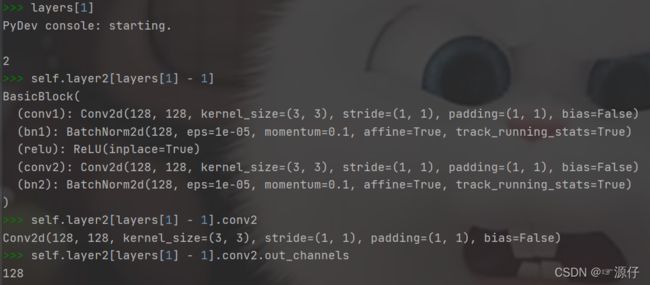
2.3、FPN详解(第3节详细分析)
注意本文P6也是通过Res5(等于C5_size)3*3*256卷积特征提取得到的。但是有的代码中是通过M5特征提取得到P6的。具体应该效果都差不多,不然不会出现这两种写法。
self.P6 = nn.Conv2d(C5_size, feature_size=256, kernel_size=3, stride=2, padding=1)
# C3_size=128, C4_size=256, C5_size=512
# feature_size=256,通过1*1*256卷积进一步获取特征
class PyramidFeatures(nn.Module):
def __init__(self, C3_size, C4_size, C5_size, feature_size=256):
super(PyramidFeatures, self).__init__()
# C5上采样得到P5
self.P5_1 = nn.Conv2d(C5_size, feature_size, kernel_size=1, stride=1, padding=0)
self.P5_upsampled = nn.Upsample(scale_factor=2, mode='nearest')
self.P5_2 = nn.Conv2d(feature_size, feature_size, kernel_size=3, stride=1, padding=1)
# add P5 elementwise to C4
self.P4_1 = nn.Conv2d(C4_size, feature_size, kernel_size=1, stride=1, padding=0)
self.P4_upsampled = nn.Upsample(scale_factor=2, mode='nearest')
self.P4_2 = nn.Conv2d(feature_size, feature_size, kernel_size=3, stride=1, padding=1)
# add P4 elementwise to C3
self.P3_1 = nn.Conv2d(C3_size, feature_size, kernel_size=1, stride=1, padding=0)
self.P3_2 = nn.Conv2d(feature_size, feature_size, kernel_size=3, stride=1, padding=1)
# "P6 is obtained via a 3x3 stride-2 conv on C5"
self.P6 = nn.Conv2d(C5_size, feature_size, kernel_size=3, stride=2, padding=1)
# "P7 is computed by applying ReLU followed by a 3x3 stride-2 conv on P6"
self.P7_1 = nn.ReLU()
self.P7_2 = nn.Conv2d(feature_size, feature_size, kernel_size=3, stride=2, padding=1)
def forward(self, inputs):
C3, C4, C5 = inputs
# C5卷积调整通道数得到M5
P5_x = self.P5_1(C5)
# M5上采样,准备与C4进行融合
P5_upsampled_x = self.P5_upsampled(P5_x)
# M5卷积经过3*3卷积核特征提取得到P5
P5_x = self.P5_2(P5_x)
# C4卷积调整通道数
P4_x = self.P4_1(C4)
# C5与C4特征融合得到M4
P4_x = P5_upsampled_x + P4_x
# C5与C4特征融合后的feature map 上采样准备与C3融合
P4_upsampled_x = self.P4_upsampled(P4_x)
# M4卷积整合特征得到P4(经过3*3卷积核特征提取)
P4_x = self.P4_2(P4_x)
# C3卷积调整通道数
P3_x = self.P3_1(C3)
# C3与C4特征融合得到M3
P3_x = P3_x + P4_upsampled_x
# M3卷积整合特征得到P3
P3_x = self.P3_2(P3_x)
# C5下采样得到P6
P6_x = self.P6(C5)
# P6下采样得到P7
P7_x = self.P7_1(P6_x)
P7_x = self.P7_2(P7_x)
return [P3_x, P4_x, P5_x, P6_x, P7_x]
2.4、Anchor.py
import numpy as np
import torch
import torch.nn as nn
class Anchors(nn.Module):
def __init__(self, pyramid_levels=None, strides=None, sizes=None, ratios=None, scales=None):
super(Anchors, self).__init__()
if pyramid_levels is None:
self.pyramid_levels = [3, 4, 5, 6, 7]
if strides is None:
#self.strides为[8,16,32,64,128]
self.strides = [2 ** x for x in self.pyramid_levels]
if sizes is None:
#self.sizes为[32,64,128,256,512] # 也就是对应的感受野大小
self.sizes = [2 ** (x + 2) for x in self.pyramid_levels]
if ratios is None:
#self.ratios为[0.5, 1, 2]:指的是长宽比,两个长方形,一个正方形
self.ratios = np.array([0.5, 1, 2])
if scales is None:
#self.scales为[1,1.26,1.59]:大小的比例
self.scales = np.array([2 ** 0, 2 ** (1.0 / 3.0), 2 ** (2.0 / 3.0)])
def forward(self, image):
# image=(B,C,H,W)
image_shape = image.shape[2:]
image_shape = np.array(image_shape)
#计算每张图片的P3到p7对应的5个feature map的宽和高,返回list,存5个元素
image_shapes = [(image_shape + 2 ** x - 1) // (2 ** x) for x in self.pyramid_levels]
# compute anchors over all pyramid levels
all_anchors = np.zeros((0, 4)).astype(np.float32)
for idx, p in enumerate(self.pyramid_levels):
#以每一个锚点为中心点(0,0),生成的9个anchor的坐标信息,格式为(x1, y1, x2, y2),左上角点的坐标和右下角点的坐标
anchors = generate_anchors(base_size=self.sizes[idx], ratios=self.ratios, scales=self.scales)
shifted_anchors = shift(image_shapes[idx], self.strides[idx], anchors)
#将shifted_anchors添加到all_anchors列表中
all_anchors = np.append(all_anchors, shifted_anchors, axis=0)
#np.expand_dims扩展all_anchors的维度
all_anchors = np.expand_dims(all_anchors, axis=0)
if torch.cuda.is_available():
return torch.from_numpy(all_anchors.astype(np.float32)).cuda()
else:
return torch.from_numpy(all_anchors.astype(np.float32))
def generate_anchors(base_size=32, ratios=None, scales=None):
"""
Generate anchor (reference) windows by enumerating aspect ratios X
scales w.r.t. a reference window.
"""
if ratios is None:
ratios = np.array([0.5, 1, 2])
if scales is None:
scales = np.array([2 ** 0, 2 ** (1.0 / 3.0), 2 ** (2.0 / 3.0)])
# 计算所有Anchors的数量
num_anchors = len(ratios) * len(scales)
# 初始化anchors,[9,4],4指每个Anchor对应的坐标
anchors = np.zeros((num_anchors, 4))
# scale base_size
# np.tile(a,(2,3))函数的作用就是将函数对X轴复制两倍,Y周复制3倍(这里的复制指对a的整体进行复制)。
anchors[:, 2:] = base_size * np.tile(scales, (2, len(ratios))).T
# compute areas of anchors
areas = anchors[:, 2] * anchors[:, 3]
#areas = [1024,1625,2580 ; 1024,1625,2580 ; 1024,1625,2580 ]
# correct for ratios
anchors[:, 2] = np.sqrt(areas / np.repeat(ratios, len(scales))) # repeats是各个ratios中的元素重复len(scales)次数
anchors[:, 3] = anchors[:, 2] * np.repeat(ratios, len(scales)) # 把H变成W的[0.5、0.5、0.5, 1、1、1 , 2,2,2]倍
# transform from (x_ctr, y_ctr, w, h) (指中心点(0,0)加宽高坐标)->沿着grid对角线向上平移到grid的中心点 (x1, y1, x2, y2) ()
# 动手画图就知道如何把Anchor第一列和第二列中的(0,0)坐标换位中心点坐标了
anchors[:, 0::2] -= np.tile(anchors[:, 2] * 0.5, (2, 1)).T
anchors[:, 1::2] -= np.tile(anchors[:, 3] * 0.5, (2, 1)).T
return anchors
def compute_shape(image_shape, pyramid_levels):
"""Compute shapes based on pyramid levels.
:param image_shape:
:param pyramid_levels:
:return:
"""
image_shape = np.array(image_shape[:2])
image_shapes = [(image_shape + 2 ** x - 1) // (2 ** x) for x in pyramid_levels]
return image_shapes
def anchors_for_shape(
image_shape,
pyramid_levels=None,
ratios=None,
scales=None,
strides=None,
sizes=None,
shapes_callback=None,
):
image_shapes = compute_shape(image_shape, pyramid_levels)
# compute anchors over all pyramid levels
all_anchors = np.zeros((0, 4))
for idx, p in enumerate(pyramid_levels):
anchors = generate_anchors(base_size=sizes[idx], ratios=ratios, scales=scales)
shifted_anchors = shift(image_shapes[idx], strides[idx], anchors)
all_anchors = np.append(all_anchors, shifted_anchors, axis=0)
return all_anchors
def shift(shape, stride, anchors):
shift_x = (np.arange(0, shape[1]) + 0.5) * stride
shift_y = (np.arange(0, shape[0]) + 0.5) * stride
'''
x = np.array([0, 1, 2])
y = np.array([0, 1])
X, Y = np.meshgrid(x, y)
print(X)
print(Y)
==========================
[[0 1 2]
[0 1 2]]
[[0 0 0]
[1 1 1]]
'''
# shift_x, shift_y:指生成网格grid,后面再加上anchors,就是每个网格对应的9个anchor-box
shift_x, shift_y = np.meshgrid(shift_x, shift_y)
# a.ravel() #用ravel()方法将数组a拉成一维数组
# np.vstack(): 行堆叠
# transpose(): 转置
shifts = np.vstack((
shift_x.ravel(), shift_y.ravel(),
shift_x.ravel(), shift_y.ravel()
)).transpose()
# add A anchors (1, A, 4) to
# cell K shifts (K, 1, 4) to get
# shift anchors (K, A, 4)
# reshape to (K*A, 4) shifted anchors
A = anchors.shape[0]
K = shifts.shape[0]
all_anchors = (anchors.reshape((1, A, 4)) + shifts.reshape((1, K, 4)).transpose((1, 0, 2)))
all_anchors = all_anchors.reshape((K * A, 4))
return all_anchors
if __name__ == '__main__':
image = np.random.rand(6,3,600,800)
anchor = Anchors()
anchor(image)
#generate_anchors(base_size=32, ratios=None, scales=None)
2. 5、resnet18、34、50、101、152
def resnet18(num_classes, pretrained=False, **kwargs):
"""Constructs a ResNet-18 model.
Args:
pretrained (bool): If True, returns a model pre-trained on ImageNet
"""
model = ResNet(num_classes, BasicBlock, [2, 2, 2, 2], **kwargs)
if pretrained:
model.load_state_dict(model_zoo.load_url(model_urls['resnet18'], model_dir='.'), strict=False)
return model
def resnet34(num_classes, pretrained=False, **kwargs):
"""Constructs a ResNet-34 model.
Args:
pretrained (bool): If True, returns a model pre-trained on ImageNet
"""
model = ResNet(num_classes, BasicBlock, [3, 4, 6, 3], **kwargs)
if pretrained:
model.load_state_dict(model_zoo.load_url(model_urls['resnet34'], model_dir='.'), strict=False)
return model
#resnet50模型
def resnet50(num_classes, pretrained=False, **kwargs):
"""Constructs a ResNet-50 model.
Args:
pretrained (bool): If True, returns a model pre-trained on ImageNet
"""
#Bottleneck为基础,每个module中Bottleneck中的数量为[3, 4, 6, 3]
#model返回为FPN输出的多尺度特征图
model = ResNet(num_classes, Bottleneck, [3, 4, 6, 3], **kwargs)
#print("======>")
#print('model:',model.shape)
if pretrained:
#pretrained参数如果为True,下载resnet50的backbone在imagenet数据集上训练好的模型
model.load_state_dict(model_zoo.load_url(model_urls['resnet50'], model_dir='.'), strict=False)
return model
def resnet101(num_classes, pretrained=False, **kwargs):
"""Constructs a ResNet-101 model.
Args:
pretrained (bool): If True, returns a model pre-trained on ImageNet
"""
model = ResNet(num_classes, Bottleneck, [3, 4, 23, 3], **kwargs)
if pretrained:
model.load_state_dict(model_zoo.load_url(model_urls['resnet101'], model_dir='.'), strict=False)
return model
def resnet152(num_classes, pretrained=False, **kwargs):
"""Constructs a ResNet-152 model.
Args:
pretrained (bool): If True, returns a model pre-trained on ImageNet
"""
model = ResNet(num_classes, Bottleneck, [3, 8, 36, 3], **kwargs)
if pretrained:
model.load_state_dict(model_zoo.load_url(model_urls['resnet152'], model_dir='.'), strict=False)
return model
3、传统FocalLoss详解
首先我们大概知道FocalLoss设计用于解决在训练过程中前景和背景类之间此乃在极端不平衡的但阶段目标检测场景(例如:1:1000).
下图中,大于$p_t>=0.5$的属于正 样本(代码中用1表示),小于0.4的为负样本(代码中用0表示),0.4到0.5之间的样本不被考虑(代码中用-1表示)。

Fig—1:probability of ground truth class
3.1、FocalLoss是怎么改进得来的?
3.1.1 CE交叉熵损失
The CE loss can be seen as the blue (top) curve in Figure 1. One notable property of this loss, which can be easilyseen in its plot, is that even examples that are easily classified (pt >= .5) incur a loss with non-trivial magnitude.When summed over a large number of easy examples, thesesmall loss values can overwhelm the rare class.图一中最上面的蓝色线指CE损失曲线。这CE损失的一个显著的特征是,可以很容易从Fig-1中看出,即使那些容易分类的样本(P >= 0.5),也会产生不小的损失。但当大量简单样本进行结合后,这些损失可以完全压制困难样本。
也就是说:因为在我们训练过程中,检测到的大多数样本都属于容易识别的样本,即负样本(又称背景),虽然这些样本的CE损失值相对与目标样本的CE损失小,但是背景样本往往比具有目标的样本多几十倍、甚至更多,所以算总CE损失时,含有目标样本的损失往往要远小于背景样本的CE损失,这会导致含有目标样本的作用微乎其微。
看下面FocalLoss程序之前我问解析一小段代码,不然容易发懵。
3.1.2、Balanced Cross Entropy
意思就是,对 c l a s s = 1 class = 1 class=1 or c l a s s = − 1 class = -1 class=−1时,也就是当正、负样本中一方出现压倒性的数量时,我们可以用权重因子 α \alpha α进行权衡。
但是我们知道,正负样本中还区分Easy/Hard exmaple,所以这里光靠权重因子 α \alpha α是无法完全解决问题的。所以作者又提出了最大的创新点Focal Loss。
3.1.3、Focal Loss Definition
我们注意到焦点损失的两个性质。(1)当一个例子被错误分类,pt很小时,调制因子接近1,损失不受影响。当 p t p_t pt→1时,因子变为0,分类良好的例子的损失被降低。(2)聚焦参数 γ \gamma γ平滑地调整简单样本其权重的减少。.例如,在 γ = 2 \gamma = 2 γ=2中, p t = 0.9 p_t=0.9 pt=0.9分类的损失比CE低 100 100 100倍,而 p t ≈ 0.968 p_t≈0.968 pt≈0.968分类的损失比比CE低 1000 1000 1000倍。
import numpy as np
targets = np.ones((6,5), dtype = np.int)*-1
print(targets)
positive_indices = [False,False,True,True,True,False]
targets[positive_indices, :] = 0
print("*---*"*10)
print(targets)
targets[positive_indices, [2,2,2]] = 1
print("*---*"*10)
print(targets)
#===============#===============#===============#===============#
[[-1 -1 -1 -1 -1]
[-1 -1 -1 -1 -1]
[-1 -1 -1 -1 -1]
[-1 -1 -1 -1 -1]
[-1 -1 -1 -1 -1]
[-1 -1 -1 -1 -1]]
*---**---**---**---**---**---**---**---**---**---*
[[-1 -1 -1 -1 -1]
[-1 -1 -1 -1 -1]
[ 0 0 0 0 0]
[ 0 0 0 0 0]
[ 0 0 0 0 0]
[-1 -1 -1 -1 -1]]
*---**---**---**---**---**---**---**---**---**---*
[[-1 -1 -1 -1 -1]
[-1 -1 -1 -1 -1]
[ 0 0 1 0 0]
[ 0 0 1 0 0]
[ 0 0 1 0 0]
[-1 -1 -1 -1 -1]]
def calc_iou(a, b):
area = (b[:, 2] - b[:, 0]) * (b[:, 3] - b[:, 1])
iw = torch.min(torch.unsqueeze(a[:, 2], dim=1), b[:, 2]) - torch.max(torch.unsqueeze(a[:, 0], 1), b[:, 0])
ih = torch.min(torch.unsqueeze(a[:, 3], dim=1), b[:, 3]) - torch.max(torch.unsqueeze(a[:, 1], 1), b[:, 1])
iw = torch.clamp(iw, min=0)
ih = torch.clamp(ih, min=0)
ua = torch.unsqueeze((a[:, 2] - a[:, 0]) * (a[:, 3] - a[:, 1]), dim=1) + area - iw * ih
ua = torch.clamp(ua, min=1e-8)
intersection = iw * ih
IoU = intersection / ua
return IoU
class FocalLoss(nn.Module):
#def __init__(self):
def forward(self, classifications, regressions, anchors, annotations):
alpha = 0.25
gamma = 2.0
batch_size = classifications.shape[0] # 6
classification_losses = []
regression_losses = []
anchor = anchors[0, :, :] # (99765,4):4是左上角、右下角坐标
# 坐标转化为中心点和宽、高形式
anchor_widths = anchor[:, 2] - anchor[:, 0]
anchor_heights = anchor[:, 3] - anchor[:, 1]
anchor_ctr_x = anchor[:, 0] + 0.5 * anchor_widths
anchor_ctr_y = anchor[:, 1] + 0.5 * anchor_heights
for j in range(batch_size):
# classifications=(6,?,20)、regressions=(6,?,4)
classification = classifications[j, :, :]
regression = regressions[j, :, :]
# annotations = (6,?,5):这里?指一个batchsize的图片中含有最大的标注框个数,没有这没多的用-1填充
bbox_annotation = annotations[j, :, :] # annotations=(x,y,w,h,class)
bbox_annotation = bbox_annotation[bbox_annotation[:, 4] != -1] # 删除用-1补充的标注框.
# 限制classification中的元素在(1e-4, 1.0 - 1e-4)之间
classification = torch.clamp(classification, 1e-4, 1.0 - 1e-4)
# 只有标注框不存在时,才会走这条路,我们用的数据都是标注后的,所以都存在。这里不用看
if bbox_annotation.shape[0] == 0: # 只有标注框不存在时,才会走这条路。
if torch.cuda.is_available():
alpha_factor = torch.ones(classification.shape).cuda() * alpha # alpha = a
alpha_factor = 1. - alpha_factor # alpha_factor(1-a)
focal_weight = classification # classification = p
focal_weight = alpha_factor * torch.pow(focal_weight, gamma) # focal_weight = p^y
bce = -(torch.log(1.0 - classification))
# cls_loss = focal_weight * torch.pow(bce, gamma)
cls_loss = focal_weight * bce
classification_losses.append(cls_loss.sum())
regression_losses.append(torch.tensor(0).float().cuda())
else: # y=1时
alpha_factor = torch.ones(classification.shape) * alpha
alpha_factor = 1. - alpha_factor
focal_weight = classification
focal_weight = alpha_factor * torch.pow(focal_weight, gamma)
bce = -(torch.log(1.0 - classification))
# cls_loss = focal_weight * torch.pow(bce, gamma)
cls_loss = focal_weight * bce
classification_losses.append(cls_loss.sum())
regression_losses.append(torch.tensor(0).float())
continue
IoU = calc_iou(anchors[0, :, :], bbox_annotation[:, :4]) # num_anchors x num_annotations
IoU_max, IoU_argmax = torch.max(IoU, dim=1) # num_anchors x 1
#import pdb
#pdb.set_trace()
# 计算分类损失
# 被忽略的样本IOU=0.4-0.5之间为被忽略的样本
targets = torch.ones(classification.shape) * -1
if torch.cuda.is_available():
targets = targets.cuda()
# 取IoU小于0.4的targets,赋值为0,为背景样本
targets[torch.lt(IoU_max, 0.4), :] = 0
# 取IoU大于等于0.5的targets,即正样本的positive indices
positive_indices = torch.ge(IoU_max, 0.5)
num_positive_anchors = positive_indices.sum()
assigned_annotations = bbox_annotation[IoU_argmax, :]
#将正样本标签赋值为1
# assigned_annotations[positive_indices, 4]:指取出索引为Ture的行的第五个元素,即标注框的种类的序号
# long():把标注框的种类的序号的小数点去除
# 指把对应索引为True的行所对应的列(标注框的类别的序号,此代码用的VOC数据集,有20个类别)改为1
targets[positive_indices, :] = 0
targets[positive_indices, assigned_annotations[positive_indices, 4].long()] = 1
if torch.cuda.is_available():
alpha_factor = torch.ones(targets.shape).cuda() * alpha
else:
alpha_factor = torch.ones(targets.shape) * alpha
#判断targets是不是等于1,是返回alpha_factor,否则返回1 - alpha_factor
# torch.eq(input, other, *, out=None):对两个张量Tensor进行逐元素的比较,若相同位置的两个元素相同,则返回True;若不同,返回False。
# torch.where(condition,a,b)其中输入参数condition:条件限制,如果满足条件,则选择a,否则选择b作为输出。
alpha_factor = torch.where(torch.eq(targets, 1.), alpha_factor, 1. - alpha_factor)
focal_weight = torch.where(torch.eq(targets, 1.), 1. - classification, classification)
focal_weight = alpha_factor * torch.pow(focal_weight, gamma)
bce = -(targets * torch.log(classification) + (1.0 - targets) * torch.log(1.0 - classification))
#计算cls_loss,根据下面的公式
# cls_loss = focal_weight * torch.pow(bce, gamma)
cls_loss = focal_weight * bce
if torch.cuda.is_available():
cls_loss = torch.where(torch.ne(targets, -1.0), cls_loss, torch.zeros(cls_loss.shape).cuda())
else:
cls_loss = torch.where(torch.ne(targets, -1.0), cls_loss, torch.zeros(cls_loss.shape))
classification_losses.append(cls_loss.sum()/torch.clamp(num_positive_anchors.float(), min=1.0))
# 计算回归损失
if positive_indices.sum() > 0:
assigned_annotations = assigned_annotations[positive_indices, :]
anchor_widths_pi = anchor_widths[positive_indices]
anchor_heights_pi = anchor_heights[positive_indices]
anchor_ctr_x_pi = anchor_ctr_x[positive_indices]
anchor_ctr_y_pi = anchor_ctr_y[positive_indices]
gt_widths = assigned_annotations[:, 2] - assigned_annotations[:, 0]
gt_heights = assigned_annotations[:, 3] - assigned_annotations[:, 1]
gt_ctr_x = assigned_annotations[:, 0] + 0.5 * gt_widths
gt_ctr_y = assigned_annotations[:, 1] + 0.5 * gt_heights
# clip widths to 1
gt_widths = torch.clamp(gt_widths, min=1)
gt_heights = torch.clamp(gt_heights, min=1)
targets_dx = (gt_ctr_x - anchor_ctr_x_pi) / anchor_widths_pi
targets_dy = (gt_ctr_y - anchor_ctr_y_pi) / anchor_heights_pi
targets_dw = torch.log(gt_widths / anchor_widths_pi)
targets_dh = torch.log(gt_heights / anchor_heights_pi)
targets = torch.stack((targets_dx, targets_dy, targets_dw, targets_dh))
targets = targets.t()
if torch.cuda.is_available():
targets = targets/torch.Tensor([[0.1, 0.1, 0.2, 0.2]]).cuda()
else:
targets = targets/torch.Tensor([[0.1, 0.1, 0.2, 0.2]])
negative_indices = 1 + (~positive_indices)
#回归使用L2损失
regression_diff = torch.abs(targets - regression[positive_indices, :])
#smooth L1
regression_loss = torch.where(
torch.le(regression_diff, 1.0 / 9.0),
0.5 * 9.0 * torch.pow(regression_diff, 2),
regression_diff - 0.5 / 9.0
)
regression_losses.append(regression_loss.mean())
else:
if torch.cuda.is_available():
regression_losses.append(torch.tensor(0).float().cuda())
else:
regression_losses.append(torch.tensor(0).float())
return torch.stack(classification_losses).mean(dim=0, keepdim=True), torch.stack(regression_losses).mean(dim=0, keepdim=True)
3、FPN特征融合
首先看一下原始的图像金字塔特征: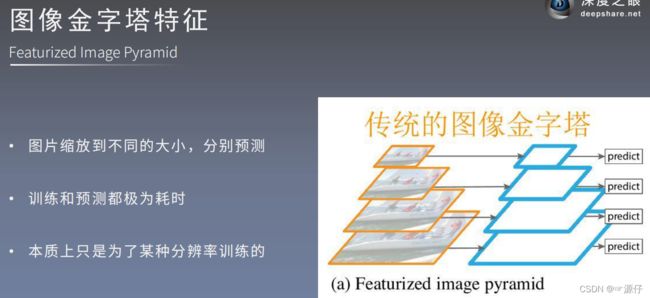
对每次对图片都要进行Resize后,再通过卷积提取图像特征信息,这个过程十分的耗时。要知道我们可以通过卷积直接对图片进行卷积的到相应的Feature Map大小。如下图:

但是我问知道我们的网络层越深,深层特征就越抽象,感受野也会越大,这样很难检测小目标。为何我们不用上浅层所提取的特征呢?浅层feature Map对应的感受野小,有利于检测小目标物体。如下图所示:

由上图可知,FPN结合了浅层的高分辨率特征以及深层的丰富的语意信息。FPN并不是独立的目标检测算法,而只是一个Backbone。
